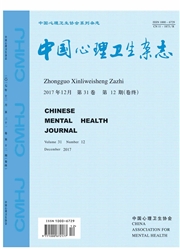

 中文摘要:
中文摘要:
目的:建立一套本土量化的情绪声音刺激库。方法:第一阶段:通过各种途径大量收集各种声音,并从中精选出453个声音;第二阶段:征集50名大学生对声音的愉悦度(V)、唤醒度(A)和优势度(D)进行了自我报告的9点量表评分。结果:男女两组在V、A、D三维度上的评分相关数分别为0.94、0.91、0.85(P〈0.01)。A维度评分男生低于女生(5.17±1.10/5.33±1.06,t=-7.63,P〈0.01);D维度评分男生高于女生(5.20±0.88/5.07±1.06,t=5.10,P〈0.01)。聚类分析可将声音聚为6类,1至6类分别包括38、100、58、58、129、70个声音,并分别对应于惊喜,平静、唤醒、愉快、厌恶、悲恐情绪。结论:大学生中男女生对部分声音的情绪感受有所不同。聚类分析结果提示可以同时从情绪维度和情绪类型两种途径研究情绪问题,两者结果也有相互比较的可能性。本情绪声音库还有待进一步完善。
 英文摘要:
英文摘要:
Objective: To establish a set of native and standardized sound system for emotional study. Methods: Firstly, diversiform sounds were collected through various approaches, of which 453 were selected for this study. Secondly, 50 Chinese university students were instructed to appraise these sounds on valence, arousal and dominance by serf- report in a 9 - point rating scale. Results: The rating scores of the male students were strongly correlated with those of female students in valence, arousal and dominance, the coefficients of which were 0. 94, 0. 91,0. 85 respoctively (P〈0.01) . The average score on arousal of males was lower than female's (5. 17 ±1. 10 vs 5. 33±1.06,t= -7. 63, P〈0. 01), and score on dominance of males was higher than female's (5.20 ±0. 88 vs 5.07 ± 1.06, t = 5.10, P 〈 0.01 ) . Six categories were found in factor analysis including 38 , 100, 58, 58, 129, 70 sounds represeating respoctively joyance with surprise, peace, arousing, pleasure, disgust, fear, Conclusion: There are difference on feelings to some sounds between male and female. The results of factor analysis might improve the communication between dimension view and category view of emotion research. It remains a further study to improve the native affectire sound system.
 同期刊论文项目
同期刊论文项目
 同项目期刊论文
同项目期刊论文
 期刊信息
期刊信息
